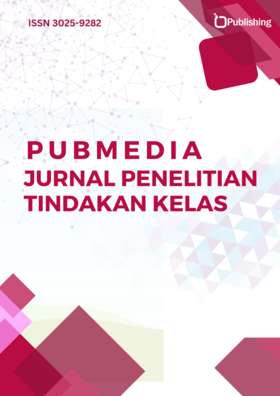Penerapan Model Pembelajaran Menyimak Teks Berita Berlandaskan Teori Berpikir Logis Secara Luring
DOI:
https://doi.org/10.47134/ptk.v1i3.421Keywords:
Menyimak, Teks Berita, Berpikir LogisAbstract
Penerapan model pembelajaran menyimak teks berita berlandaskan teori berpikir logis secara luring adalah upaya untuk meningkatkan pemahaman siswa terhadap informasi yang disajikan dalam teks berita. Penelitian ini bertujuan untuk mengevaluasi efektivitas model tersebut dalam konteks pembelajaran bahasa dan sastra. Metode kualitatif digunakan dalam penelitian ini, yang melibatkan pengamatan terhadap pelaksanaan model pembelajaran di lingkungan kelas. Penelitian ini menyoroti pentingnya penerapan strategi yang sesuai dengan prinsip-prinsip berpikir logis dalam proses pembelajaran menyimak teks berita. Temuan menunjukkan bahwa model pembelajaran ini dapat membantu siswa mengembangkan kemampuan dalam menguraikan informasi secara sistematis dan logis dari teks berita yang kompleks. Hasil penelitian ini memberikan pemahaman yang lebih mendalam tentang bagaimana model pembelajaran tersebut dapat memfasilitasi proses belajar menyimak teks berita secara efektif. Implikasi praktis dari penelitian ini adalah pentingnya mengintegrasikan strategi pembelajaran yang memanfaatkan teori berpikir logis dalam pengajaran menyimak teks berita. Diharapkan hasil penelitian ini dapat memberikan sumbangan bagi pengembangan kurikulum dan pendekatan pembelajaran yang lebih berorientasi pada kemampuan berpikir kritis dan analitis siswa. Penelitian lanjutan direkomendasikan untuk mengeksplorasi lebih lanjut tentang berbagai metode dan strategi yang dapat digunakan dalam meningkatkan pemahaman menyimak teks berita di lingkungan pendidikan.
References
Assegaf, D. (1991). Jurnalistik masa kini. Jakarta: Ghalia Indonesia.
Bedoya, I. A. (2022). Educational Programming as a Strategy for the Development of Logical-Mathematical Thinking. Lecture Notes in Networks and Systems, 405, 309–323. https://doi.org/10.1007/978-3-030-96043-8_24 DOI: https://doi.org/10.1007/978-3-030-96043-8_24
Boockmann, J. H. (2024). Comprehending Object State via Dynamic Class Invariant Learning. Lecture Notes in Computer Science (Including Subseries Lecture Notes in Artificial Intelligence and Lecture Notes in Bioinformatics), 14573, 143–164. https://doi.org/10.1007/978-3-031-57259-3_7 DOI: https://doi.org/10.1007/978-3-031-57259-3_7
Carl, M. O. (2020). Qualitative Content Analysis in Educational Studies on Literary Learning: The Challenge of Comprehending Comprehension. Forum Qualitative Sozialforschung, 21(1). https://doi.org/10.17169/fqs-21.1.3428
Chhabra, S. (2021). Comprehending entrepreneurship learning through the lens of innovative teaching pedagogy: India vs germany. Proceedings of the European Conference on E-Learning, ECEL, 98–104. https://doi.org/10.34190/EEL.21.089
Ding, M. (2020). Logical creative thinking methods. Logical Creative Thinking Methods, 1–218. https://doi.org/10.4324/9781003017752 DOI: https://doi.org/10.4324/9781003017752
Frolova, E. V. (2021). Particularities of students perceptions of the digitalization of education: Comprehending the experience of online learning in a pandemic environment. Perspektivy Nauki i Obrazovania, 51(3), 43–54. https://doi.org/10.32744/pse.2021.3.3 DOI: https://doi.org/10.32744/pse.2021.3.3
Hendra. (2021). Pembelajaran kontekstual (CTL) terhadap kemampuan berpikir kritis siswa dalam pembelajaran IPA pada kelas IX di sekolah menengah pertama. Prosiding Seminar Nasional Pendidikan IPA, 1(1), 139-146.
Herizal, H. (2019). The ability of senior high school students in comprehending mathematical proofs. Journal of Physics: Conference Series, 1157(2). https://doi.org/10.1088/1742-6596/1157/2/022123 DOI: https://doi.org/10.1088/1742-6596/1157/2/022123
Heryadi, D. (2014). Kemahiran menyimak. Tasikmalaya: Program Pascasarjana Unsil.
Hu, C. (2022). Reverse Thinking: The Logical System Research Method of Urban Thermal Safety Pattern Construction, Evaluation, and Optimization. Remote Sensing, 14(23). https://doi.org/10.3390/rs14236036 DOI: https://doi.org/10.3390/rs14236036
James, M. X. (2019). Comprehending the Cultural Causes of English Writing Plagiarism in Chinese Students at a Western-Style University. Journal of Business Ethics, 154(3), 631–642. https://doi.org/10.1007/s10551-017-3441-6 DOI: https://doi.org/10.1007/s10551-017-3441-6
Kikas, E. (2021). Effects of Prior Knowledge on Comprehending Text About Learning Strategies. Frontiers in Education, 6. https://doi.org/10.3389/feduc.2021.766589 DOI: https://doi.org/10.3389/feduc.2021.766589
Mahan, K. R. (2022). The comprehending teacher: scaffolding in content and language integrated learning (CLIL). Language Learning Journal, 50(1), 74–88. https://doi.org/10.1080/09571736.2019.1705879 DOI: https://doi.org/10.1080/09571736.2019.1705879
Miles, B. M., & Huberman, M. A. (2014). An analytic approach for discovery. In CEUR Workshop Proceedings (Vol. 1304, pp. 89-92).
Moschella, M. (2020). Computational thinking, spatial and logical skills. An investigation at primary school. Ricerche Di Pedagogia e Didattica, 15(2), 69–89. https://doi.org/10.6092/issn.1970-2221/11583
Mukhtar. (2013). Metode praktis penelitian deskriptif kualitatif. GP Press Group.
Muzaky, A. F. (2020). Evaluating students logical thinking ability: TPACK model as a physics learning strategy to improve students logical thinking ability. Journal of Physics: Conference Series, 1511(1). https://doi.org/10.1088/1742-6596/1511/1/012027 DOI: https://doi.org/10.1088/1742-6596/1511/1/012027
Nainwal, A. (2023). A Comprehending Deep Learning Approach for Disease Classification. Lecture Notes in Networks and Systems, 528, 113–122. https://doi.org/10.1007/978-981-19-5845-8_9 DOI: https://doi.org/10.1007/978-981-19-5845-8_9
Prasad, P. (2020). VeriSIM: A learning environment for comprehending class and sequence diagrams using design tracing. Proceedings - International Conference on Software Engineering, 23–33. https://doi.org/10.1145/3377814.3381705 DOI: https://doi.org/10.1145/3377814.3381705
Priyanka, M. (2022). Comprehending Object Detection by Deep Learning Methods and Algorithms. Lecture Notes on Data Engineering and Communications Technologies, 126, 523–537. https://doi.org/10.1007/978-981-19-2069-1_36 DOI: https://doi.org/10.1007/978-981-19-2069-1_36
Rahma, R. A. (2020). The Effectiveness of Augmented Reality-Based Board Game as Learning Media in Comprehending Family Functions Concept. Proceedings - 2020 6th International Conference on Education and Technology, ICET 2020, 102–108. https://doi.org/10.1109/ICET51153.2020.9276584 DOI: https://doi.org/10.1109/ICET51153.2020.9276584
Riyanti, H. (2019). The relationship between logical-thinking ability and science achievement of middle school students. Journal of Physics: Conference Series, 1241(1). https://doi.org/10.1088/1742-6596/1241/1/012024 DOI: https://doi.org/10.1088/1742-6596/1241/1/012024
Scott, J. A. (2020). Comprehending Science Writing: The Promise of Dialogic Reading for Supporting Upper Elementary Deaf Students. Communication Disorders Quarterly, 41(2), 100–109. https://doi.org/10.1177/1525740119838253 DOI: https://doi.org/10.1177/1525740119838253
Shilo, G. (2023). Students’ abilities to formulate exhaustive titles as a key to comprehending arguments. International Journal of Applied Linguistics (United Kingdom), 33(2), 132–149. https://doi.org/10.1111/ijal.12454 DOI: https://doi.org/10.1111/ijal.12454
Skurvydas, A. (2022). What Types of Exercise Are Best for Emotional Intelligence and Logical Thinking? International Journal of Environmental Research and Public Health, 19(16). https://doi.org/10.3390/ijerph191610076 DOI: https://doi.org/10.3390/ijerph191610076
Sumadiria, H. (2011). Jurnalistik Indonesia: Menulis berita dan feature. Bandung: Simbiosa Rekatama Media.
Tibaijuka, A. (2022). Comprehending the lenience on academic assessment regulations through university students’ emotional insights in Tanzania. Empathy and Business Transformation, 92–103. https://doi.org/10.4324/9781003227557-9 DOI: https://doi.org/10.4324/9781003227557-9
Townsend, D. (2020). Learning Academic Language, Comprehending Text. Handbook of Reading Research, Volume V, 345–364. https://doi.org/10.4324/9781315676302-18 DOI: https://doi.org/10.4324/9781315676302-18
Trinaldi, A., Bambang, S. E. M., Afriani, M., Rahma, F. A., & Rustam. (2022). Analisis kebutuhan penggunaan bahan ajar berbasis teknologi informasi. Jurnal Basicedu, 6(6), 9304-9314. https://jbasic.org/index.php/basicedu/article/view/4037 DOI: https://doi.org/10.31004/basicedu.v6i6.4037
Downloads
Published
How to Cite
Issue
Section
License
Copyright (c) 2024 Ninda Dawilatul Aliyah, Azmia Mar’atul Latipah, Dina Alistri, Yuni Ertinawati

This work is licensed under a Creative Commons Attribution 4.0 International License.










